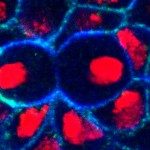Lien vers Pubmed [PMID] – 8287797
Development 1993 Oct;119(2):471-83
A dramatic reorganization of the cytoskeleton underlies the cellularisation of the syncytial Drosophila embryo. Formation of a regular network of acto-myosin filaments, providing a structural framework, and possibly a contractile force as well, appears essential for the synchronous invagination of the plasma membrane between adjacent nuclei. The serendipity alpha (sry alpha) gene is required for this complete reorganization of the microfilaments at the onset of membrane invagination. We compare here the structure and expression of sry alpha between D. pseudoobscura, D. subobscura and D. melanogaster. Interspersion of evolutionarily highly conserved and divergent regions is observed in the protein. One such highly conserved region shows sequence similarities to a motif found in proteins of the ezrin-radixin-moesin (ERM) family. Four 7-13 bp motifs are conserved in the 5′ promoter region; two of these are also found, and at the same position relative to the TATA box, in nullo, another zygotic gene recently shown to be involved in cellularisation. The compared patterns of expression of D. melanogaster sry alpha and nullo, and D. pseudoobscura sry alpha reveal a complex regulation of the spatiotemporal accumulation of their transcripts. The D. pseudoobscura sry alpha gene is able to rescue the cellularisation defects associated with a complete loss of sry alpha function in D. melanogaster embryos, even though species-specific aspects of its expression are maintained. Despite their functional homologies, the D. melanogaster and D. pseudoobscura sry alpha RNAs have different subcellular localisations, suggesting that this specific localization has no conserved role in targeting the sry alpha protein to the apical membranes.

